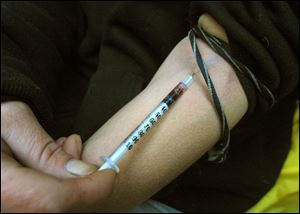
EDITORIAL
Act now on opioids
Lawmakers can make a difference in Ohio’s opioid and heroin epidemic by approving simple changes
3/29/2014
Sears
State lawmakers have introduced an 11-bill package that aims to alleviate Ohio’s opioid and heroin epidemic. Dealing with education, treatment, regulation, and interdiction, these bills would, overall, help the state control a public health crisis that kills more than three Ohioans a day and has put more than 200,000 in the throes of addiction.

Sears
Some of these bills require investments by the state — and spending money always invites controversy and delay. House Bill 369, for example, would, among other things, require counties to provide resources for detoxification, medication-assistant treatment, individual and group therapy, residential treatment, and peer mentoring.
Ohio badly needs this bill, because the state now provides drug treatment for as few as one in 10 people who need it. Even so, only the naive would expect this legislation to reach the governor’s desk without considerable debate.
Click here to read more Blade editorials.
But several other bills in this package have little — or no — fiscal impact on the state, local governments, or private agencies. Still, they make needed improvements in policy. Legislators ought to approve them without undue delay or debate.
House Bill 359 requires prescribers to provide patients who receive prescription opioids with a fact sheet about the drugs, including their addictive properties. House Bill 314 generally prevents the prescribing of opioids to minors without parental consent, while including vital exceptions for emergencies and cases in which unconsenting parents or guardians would endanger their children.
House Bill 363 creates so-called Good Samaritan exemptions that prevent law enforcement authorities from charging someone with minor drug possession if that person was trying to assist an overdose victim.
House Bill 399 creates a Prescription Drug Abuse Awareness and Education Day during May, which is Substance Abuse Awareness and Education Month.

The 11-bill package that state lawmakers are weighing deals with education, treatment, regulation, and interdiction, and would help Ohio control a public health crisis. Shown, a user injects heroin.
And House Bill 381 would require everyone who picks up a prescription to provide an acceptable form of identification. Among other things, it would help prevent the illicit diversion of opioids such as vicodin and OxyContin. This bill too should move as quickly as possible — with one change.
Ohio’s 28 prisons release more than 22,500 inmates a year, and many of them leave without an official state identification card or driver’s license. As part of its re-entry efforts, the Ohio Department of Rehabilitation and Correction is working to ensure that fewer inmates leave prison without an official state ID. Until that happens, this bill, sponsored by Rep. Barbara Sears (R., Monclova Township), should explicitly recognize Offender Release Cards issued by the department, which includes photographs, as acceptable documents for picking up prescriptions. In an interview with The Blade editorial page, Ms. Sears said she would make that change.
These four simple and straightforward bills, costing little or nothing, won’t erase Ohio’s opioid and heroin epidemic. But lawmakers can, and should, make a difference by approving them without undue delay or debate.